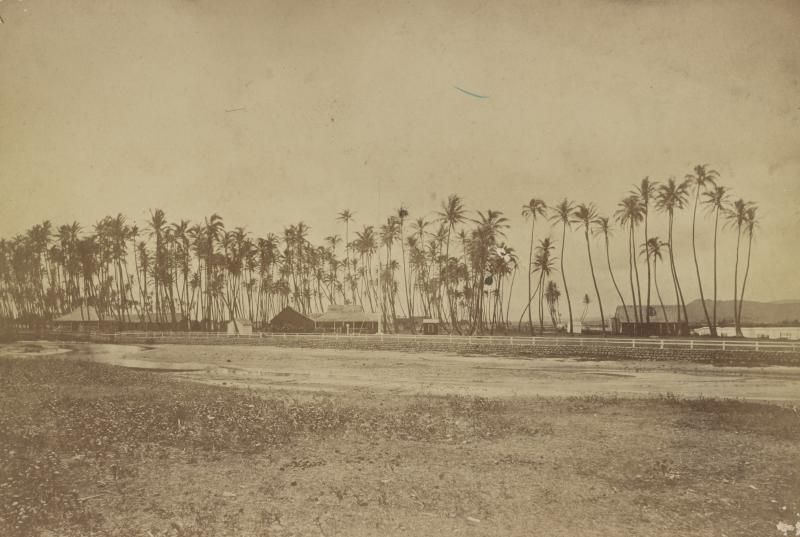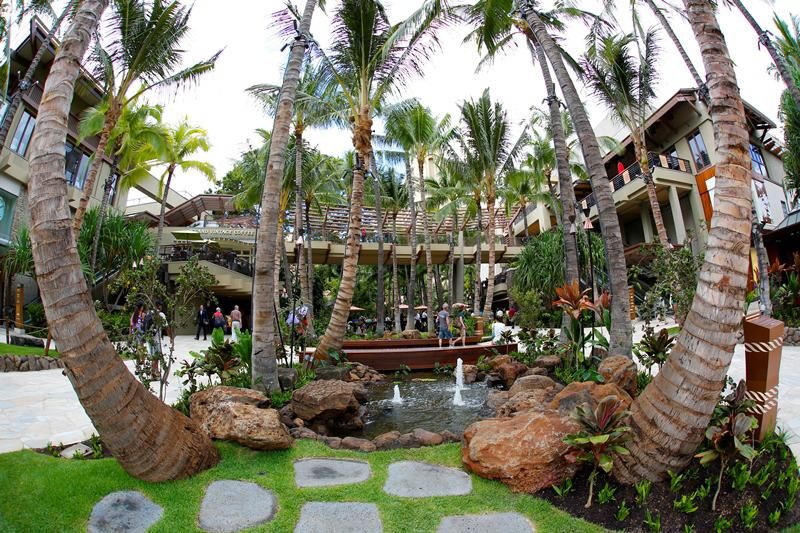Digital Collections
Celebrating the breadth and depth of Hawaiian knowledge. Amplifying Pacific voices of resiliency and hope. Recording the wisdom of past and present to help shape our future.
Melehina Groves
A friend and I were recently discussing how the effort to reclaim our identity as Hawaiians can begin by simply retelling our own stories, on our own terms. When we celebrate the name and the history of a place and the people who thrived there long before development vastly altered its face, we perform a subtle act of kū‘ē, of standing against a tide of change and loss. This is not an act of petulant wave making, as some people may believe, but rather an act of honoring our kūpuna, who we make live again every time our breath gives life to their stories.
"Ma o kēia keiki e ola ana nā iwi o nā kūpuna." It is through this child that the bones of the ancestors live on.
This re-telling of stories, of once again placing great value on those things that came before us, has become a focal point in the Kamehameha Schools’ revitalization of one of Waikīkī’s landmark sites, the Royal Hawaiian Shopping Center.
The land known as Helumoa, upon which the Royal Hawaiian Shopping Center was built, was once the seat of Hawaiian nobility, a thriving community famed for its abundance and beauty. This is one ‘āina whose stories are about to live again.
On July 20, a ho‘ola‘a, or rededication ceremony, was held at the Fountain Courtyard of the Royal Hawaiian Shopping Center in Waikīkī. Close to 200 people attended the ceremony, which marked the beginning of planned renovations for the Center by the Kamehameha Schools and its partner, the Festival Companies. Both parties expressed their dedication to revitalizing not only the Center, but also the spirit and legacy of Helumoa, the land upon which the Center was built 28 years ago.
Kahu Kordell Kekoa presided over the ceremonies, which included comments by Kamehameha Schools Trustee Diane Plotts, Lt. Governor James "Duke" Aiona, Rosalind Schurgin (executive vice president, The Festivals Companies), and Kamehameha Schools CEO Dee Jay Mailer.
"We are just trying to be good stewards and to carry out your legacy," said Kamehameha Schools Trustee Diane Plotts, when I posed the question of what she would say to the Princess Bernice Pauahi Bishop, if given one opportunity.
"We can never thank her enough for all that she has left. We’re just honored to be here," Trustee Plotts continued. Those involved in the planned renovations of the Royal Hawaiian Shopping Center say they are committed to bringing the rich legacy of Helumoa back to the forefront and, in fact, the theme for the renovations is Hanohano Helumoa, or Magnificent is Helumoa.
It is especially important that we retell our own stories in a place like Waikīkī, which is surely not the first place one expects to experience Hawaiian culture. But this impression is born only of the Waikīkī we have come to know relatively recently.
Bernice Pauahi Bishop made the site at Helumoa her home in the 1870s and 1880s. Her presence is especially strong near the large banyan tree, at the piko of the shopping center, where stories of her playing with children, cradling them in her lap, were shared by CEO Dee Jay Mailer as part of the area’s rich history.
It is a fitting image for the benefactress of the Kamehameha Schools. It was at Helumoa that Pauahi, in 1884, wrote the last two codicils to her will and bequeathed her estate to the children of Hawai‘i through the establishment of these schools [1].
CEO Mailer pointed out that the planned renovations to the Royal Hawaiian Shopping Center help ensure that the Schools can continue to thrive and successfully carry out Pauahi’s mission of educating children of Hawaiian ancestry.
"The [Royal Hawaiian Shopping] Center is one of the most important assets of the Kamehameha Schools," she affirmed while addressing the audience at the rededication ceremony. The Shopping Center supports endowments which, in turn, support the keiki to whom Kamehameha Schools reaches out to. Mailer also stressed the efforts being made to recognize and celebrate the legacy of the land here.
"This will be a place to perpetuate ‘ike Hawai‘i, or the knowledge of things Hawaiian," she stated.
This dedication to foster ‘ike Hawai‘i seemed to have already begun with the ho‘okupu, or offering, of a hula noho ‘ulī‘ulī, "Ehuehu mai nei ‘o Mānoa," by five young students of the Kamehameha Schools. They are dancers for Nā Wāhine Hele Lā o Kaiona and of kumu hula Māpuana de Silva. Kaleo Trinidad, of the Kamehameha Schools Performing Arts Department, opened the ceremonies with an oli aloha and also gave another oli in honor of Pauahi.
When asked what she would like to say to Pauahi on that special occasion, de Silva stated, "I think I would tell her, ‘I hope you’re proud of my work, because I do it in your honor’." She refers to her twenty-five years of voluntary hula instruction at the Kamehameha Schools, which, she emphasized, is all done out of respect and love for Pauahi.
As the ceremony continued, it was made clear that the renovation plans for the Shopping Center are designed to highlight the history of Helumoa, a traditional division of land within the ahupua‘a of Waikīkī.
Oren Schlieman, President and Creative Director of Info Grafik, the design team responsible for the conceptual planning of the new center, also led a small group of us through the Shopping Center on a private tour, pointing out the planned changes and what the architectural team envisioned from a technical standpoint.
Schlieman says they are also deeply concerned with the proper retelling of Helumoa’s story, looking to the guidance and opinions of cultural specialists who are involved in the project to ensure appropriate representations of the area’s significance.
Through all of the planning stages, it is imperative that the history of Helumoa be accurately represented. While the Royal Hawaiian Shopping Center is undeniably a tourist attraction, the purpose will not be to cater solely to a consumer market, but rather to attract locals back to Waikīkī and to give us a place to be proud of.
Hopefully, this is an opportunity for Hawaiians to share what we wish to share, on a large scale, with a diverse audience. Cultural specialists emphasize that there are always mo‘olelo, significant places, and information that are culturally sensitive, and it is important that these are recognized and treated as such.
There is much to be shared regarding this ‘āina, a fact which may surprise people who know the Waikīkī area as merely a tourist destination. Helumoa’s cultural significance dates back to the days of antiquity, with archaeological data showing well established settlements by 1400 AD, an indication that settlement probably occurred several centuries earlier [2].
One story of how Helumoa came upon its name involves Kākuhihewa, ruling chief of O‘ahu from 1640 to 1660. It is said that the supernatural chicken, Ka‘auhelemoa, one day flew down from his home in Ka‘au Crater, in Pālolo, and landed at Helumoa. The rooster scratched the dirt at Kākuhihewa’s feet, then disappeared as suddenly and mysteriously as he had appeared. Kākuhihewa immediately ordered his people to plant a coconut tree at the exact site upon which Ka‘auhelemoa had kicked up the dirt. This tree, which grew to be the tallest in the area, is said to be the parent of what would become an entire grove of coconut trees, and the land became known as Helumoa, ‘chicken scratch’ [3]. This is the same coconut grove that would later be called the King’s Grove, or the Royal Grove, and would be cited in numerous historical accounts for its pleasantness and lush surroundings.
Helumoa also became a favorite retreat, and a home, for ali‘i throughout the ages. Mā‘ilikūkahi, an O‘ahu ali‘i who moved the center of government on O‘ahu to Waikīkī in the 1400s, is said to have been one of the first to reside here [4].
Ali‘i nui Kalamakuaakaipuholua, who ruled in the early 1500s, is credited for his major work in establishing lo‘i kalo in the area, as well as for encouraging cultivation throughout the land. His daughter, the famed Lā‘ieloheloheikawai, is also said to have been born at Helumoa [5].
For those of us who are familiar with Hawaiian mo‘olelo, the famous "po‘o nui maka ‘ā‘ā," Kaweloleimakua, also came to Helumoa to participate in wrestling matches in the shade of the coconut grove during the reign of Kākuhihewa.
In later times, Kamehameha V, Lot Kapuāiwa, built a small vacation retreat at Helumoa. After his death in 1872, Bernice Pauahi Bishop and her husband, Charles Reed Bishop, remodeled the home and are said to have been very happy here. Upon her return from San Francisco, in the last days of her battle with breast cancer, Pauahi returned to Helumoa [6]. Although the Princess could have gone anywhere to recuperate, she longed for the tranquility and fond memories Helumoa inspired.
It was here that Pauahi wrote the last two codicils of her will, bequeathing her estate to the children of Hawai‘i and, in essence, creating the Kamehameha Schools. It was her desire to continue to foster and care for her people, even though she knew it would not be long before she would physically depart from them, forever.
Although there is so much more to be shared about Helumoa, it is already apparent that there is much about this ‘āina to be celebrated, much to be proud of, and much to be preserved. It is our hope that reclaiming these stories will breathe new life into this land, into our kūpuna who traveled the road before us, and into our benefactress, the Princess Bernice Pauahi Bishop, who, undoubtedly, would so love to sit in the shade at Helumoa with us once again.
Research provided by Helen Wong Smith, Historical/Cultural Specialist

photo credit: Library of Congress
Kamehameha V’s hale at Waikīkī as it looked in 1880.

photo credit: Ka Ipu o Lono
The Royal Grove at Helumoa in 2013, after the renovation of the Royal Hawaiian Shopping Center.